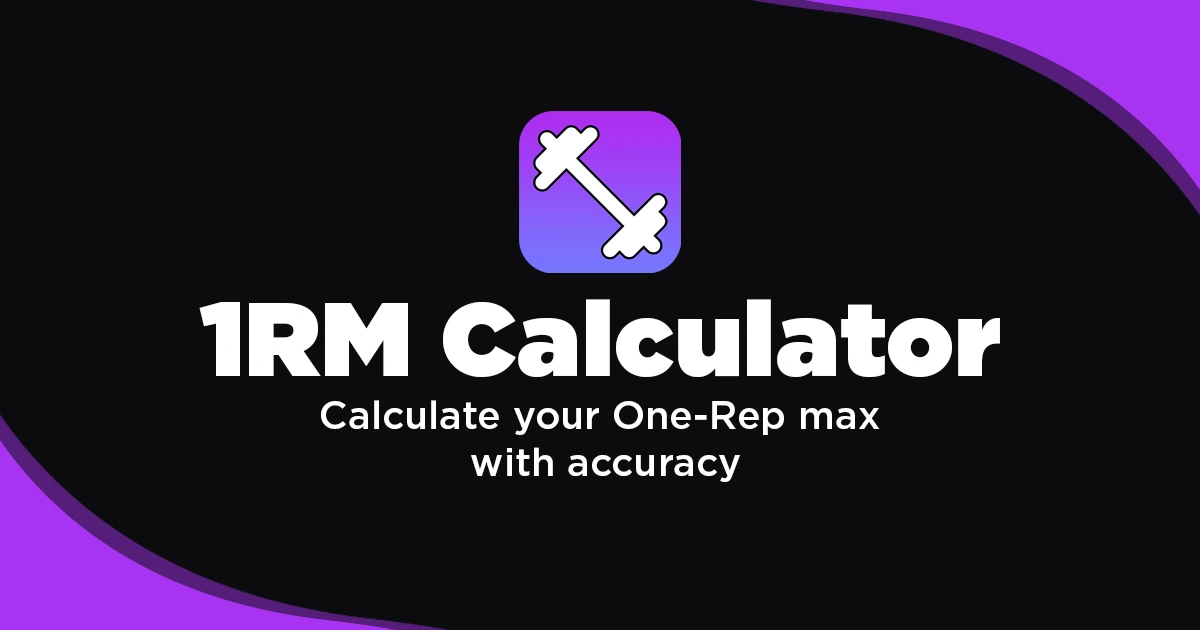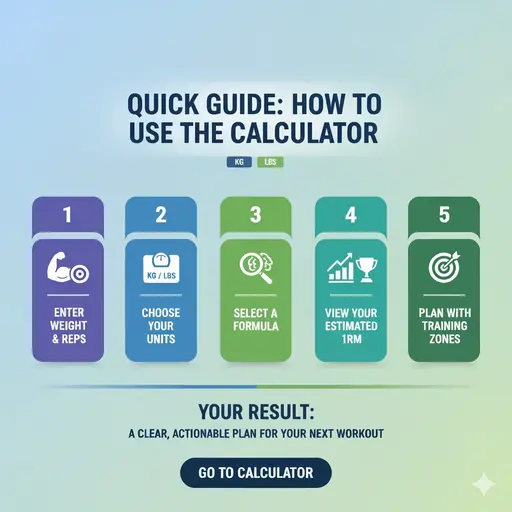Calculate Your 1RM
Results
Your 1RM
Training Percentages
Rep Range Guide
Enter your lift details to calculate your 1RM
Fill out the form to see your results
Accurate Formulas
Uses proven scientific formulas including Epley, Brzycki, Lombardi, and O'Conner methods.
Training Percentages
Get precise training loads for different rep ranges and intensity zones.
Instant Results
Real-time calculations with beautiful, easy-to-read results display.

If you're serious about getting stronger, you need more than guesswork - you need data you can trust. Our 1RM Calculator helps you accurately estimate your one-rep max (1RM) for lifts like the bench press, squat, deadlift, and overhead press, so you can choose the right weight, train smarter, and make consistent progress. Whether you're a beginner learning the basics or an experienced lifter fine-tuning your programming, this tool is designed to meet you where you are and help you grow. For detailed instructions on maximizing your results, check out our comprehensive 1RM Calculator Guide.
What Is a 1RM and Why It Matters
Your one-rep max is the maximum amount of weight you can lift for a single repetition with perfect form. Knowing your 1RM matters because it becomes the foundation for precise training loads. Instead of lifting "heavy" or "light" based on feel, you can use objective percentages of your 1RM like 70%, 80%, or 90% to target strength, power, or hypertrophy with intention. That means safer sessions, more efficient workouts, and measurable progress.
How to Use the Calculator (Quick Guide)
- Enter the weight you lifted and the number of clean reps you performed.
- Choose your preferred unit (kg or lbs).
- Select a formula or compare all to see a reliable estimate.
- Use the training percentage breakdown to plan your next sets and sessions.
- Apply the rep range guide to match your goal: strength, muscle gain, or endurance.
You'll see your estimated 1RM, plus the weights that correspond to common training zones. The result is a clear, actionable plan for your next workout.

Why This 1RM Calculator Is Different
This calculator isn't a gimmick - it's built on time-tested, research-backed formulas used by coaches and athletes around the world:
- Epley (great all-rounder for 2-10 reps)
- Brzycki (often more conservative, helpful for higher rep sets)
- Lombardi (uses an exponential relationship, favored by some advanced lifters)
- O'Conner (slightly conservative and beginner-friendly)
No single formula fits everyone perfectly, which is why we let you compare them quickly. You get a realistic range and the confidence to choose the number that fits your training history and how you felt on the day.
Training Percentages Made Simple
Once you have your estimated 1RM, the next step is using it. Here's a practical way to apply it:
- 90-95% 1RM: Heavy singles/doubles for peak strength and testing (low volume)
- 80-85% 1RM: Strength building (3-5 reps per set)
- 70-80% 1RM: Strength-hypertrophy blend (6-8 reps)
- 65-75% 1RM: Hypertrophy focus (8-12 reps)
- 60-65% 1RM: Technique work, deloads, and recovery days
This structure removes the guesswork and helps you progress without burning out.
Who This Is For
- New lifters who want a safe, structured path to strength gains
- Intermediate athletes who need to break plateaus with better planning
- Advanced trainees optimizing cycles for performance or competition
- Coaches who want a clean, fast way to calculate training loads for clients
If you value progress you can measure and repeat, this tool is for you. Want to learn more about the science behind our calculations? Visit our About page to discover the research-backed methodology we use.
Tips for Accurate Estimates
- Use a recent, quality set. Choose a weight you lifted with solid form in the last 2-4 weeks.
- Keep reps in the 1-10 range for best accuracy (the closer to 1-6, the better).
- Record how the set felt (RPE/RIR) and compare trends over time.
- Stick to consistent technique - depth on squats, pause on bench, and clean lockouts.
- If two formulas differ slightly, pick the number that matches your experience and recovery.
Common Mistakes to Avoid
- Rounding up aggressively. If anything, start slightly lower and earn your jumps.
- Testing too often. Max-effort testing is taxing; calculated estimates are safer for ongoing training.
- Ignoring recovery. Sleep, stress, and nutrition affect strength more than most realize.
- Changing technique under heavy load. Always prioritize form - your joints will thank you.
How Often Should You Recalculate?
Recalculate after a notable performance like a rep PR, a stronger top set, or the end of a training block. Many lifters recheck their estimated 1RM every 3-6 weeks, depending on goals and training style. The key is consistency: track your numbers, increase thoughtfully, and let the data guide your decisions.
Safety First, Always
Strength training is one of the most rewarding forms of exercise but it demands respect. Warm up thoroughly, progress gradually, and don't hesitate to use a spotter or safety pins when lifting near your max. If you're new to lifting or returning from injury, consult a qualified professional and learn proper technique before chasing numbers. Learn more about our commitment to safe training practices on our About page.
Bench, Squat, Deadlift, and More
You can use this calculator for any major lift. For compound movements like the bench press, squat, and deadlift, the formulas typically perform very well. For isolation exercises (like curls or triceps extensions), results may be less precise - use the estimate as a guide rather than an absolute.
How Strong Should You Be?
Strength is personal. What matters most is that you're improving relative to your own baseline. With consistent training and smart progression using clean 1RM calculations, you'll build strength you can trust. Week by week, block by block, your numbers will climb and your confidence with them.
Your Next Steps
- Use the calculator with your latest solid set.
- Pick a realistic training percentage for your goal.
- Plan your next 4-8 weeks with progressive overload.
- Track results and adjust based on performance and recovery.
Strength is a skill. With accurate numbers and a clear plan, you'll train with purpose, avoid stalls, and build momentum that lasts.
Final Word
The best lifters don't leave their training to chance - they measure, plan, and execute. This 1RM Calculator gives you a professional tool to do exactly that. No fluff, no guesswork - just reliable numbers and a clear path forward. Lift with intention, trust the process, and let your progress tell the story. Have questions about using the calculator? Check our FAQ section or contact us for personalized support.
Watch: 1RM Training Explained
